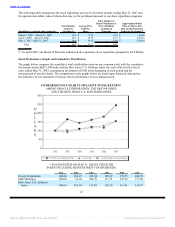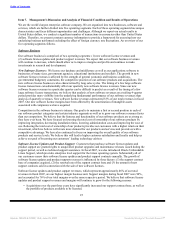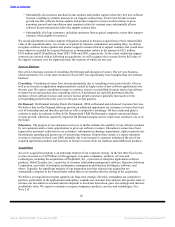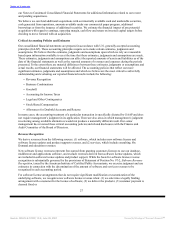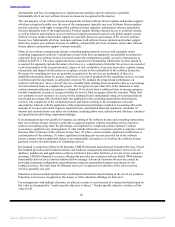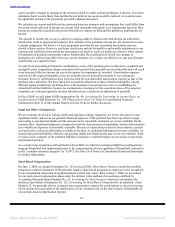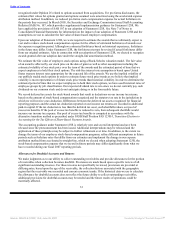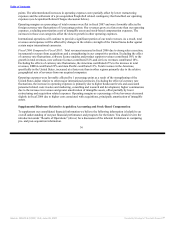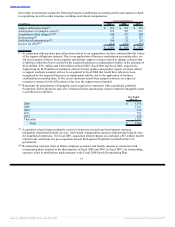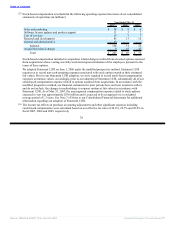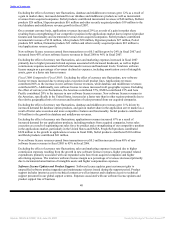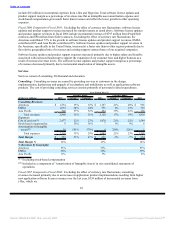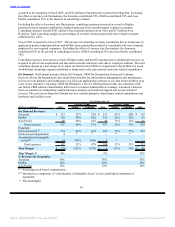Oracle 2006 Annual Report Download - page 37
Download and view the complete annual report
Please find page 37 of the 2006 Oracle annual report below. You can navigate through the pages in the report by either clicking on the pages listed below, or by using the keyword search tool below to find specific information within the annual report.
Table of Contents
recognized under Opinion 25 related to options assumed from acquisitions. For pro forma disclosures, the
estimated fair values for options granted and options assumed were amortized using the accelerated expense
attribution method. In addition, we reduced pro forma stock compensation expense for actual forfeitures in
the periods they occurred. In March 2005, the Securities and Exchange Commission issued Staff Accounting
Bulletin (SAB) No. 107, which provides supplemental implementation guidance for Statement 123R. We
have applied the provisions of SAB 107 in our adoption of Statement 123R. See Note 7 of Notes to
Consolidated Financial Statements for information on the impact of our adoption of Statement 123R and the
assumptions we use to calculate the fair value of share-based employee compensation.
Upon our adoption of Statement 123R, we were required to estimate the awards that we ultimately expect to
vest and to reduce stock-based compensation expense for the effects of estimated forfeitures of awards over
the expense recognition period. Although we estimated forfeitures based on historical experience, forfeitures
in the future may differ. Under Statement 123R, the forfeiture rate must be revised if actual forfeitures differ
from our original estimates. Also in connection with our adoption of Statement 123R, we elected to recognize
awards granted after our adoption date under the straight-line amortization method.
We estimate the fair value of employee stock options using a Black-Scholes valuation model. The fair value
of an award is affected by our stock price on the date of grant as well as other assumptions including the
estimated volatility of our stock price over the term of the awards and the estimated period of time that we
expect employees to hold their stock options. The risk-free interest rate assumption is based upon United
States treasury interest rates appropriate for the expected life of the awards. We use the implied volatility of
our publicly traded stock options in order to estimate future stock price trends as we believe that implied
volatility is more representative of future stock price trends than historical volatility. In order to determine the
estimated period of time that we expect employees to hold their stock options, we have used historical rates of
employee groups by job classification. Our expected dividend rate is zero since we do not currently pay cash
dividends on our common stock and do not anticipate doing so in the foreseeable future.
We record deferred tax assets for stock-based awards that result in deductions on our income tax returns,
based on the amount of stock-based compensation recognized and the statutory tax rate in the jurisdiction in
which we will receive a tax deduction. Differences between the deferred tax assets recognized for financial
reporting purposes and the actual tax deduction reported on our income tax returns are recorded in additional
paid-in capital. If the tax deduction is less than the deferred tax asset, such shortfalls reduce our pool of
excess tax benefits. If the pool of excess tax benefits is reduced to zero, then subsequent shortfalls would
increase our income tax expense. Our pool of excess tax benefits is computed in accordance with the
alternative transition method as prescribed under FASB Staff Position FAS 123R-3, Transition Election to
Accounting for the Tax Effects of Share-Based Payment Awards.
The accounting guidance under Statement 123R is relatively new and several interpretations have been
released since the pronouncement has been issued. Additional interpretations may be released and the
application of these principles may be subject to further refinement over time. In addition, to the extent we
change the terms of our employee stock-based compensation programs, refine different assumptions in future
periods such as forfeiture rates that differ from our estimates and implement the change in our expense
attribution method from accelerated to straight-line, which we elected when adopting Statement 123R, the
stock-based compensation expense that we record in future periods may differ significantly from what we
have recorded during our fiscal 2007 reporting periods.
Allowances for Doubtful Accounts and Returns
We make judgments as to our ability to collect outstanding receivables and provide allowances for the portion
of receivables when collection becomes doubtful. Provisions are made based upon a specific review of all
significant outstanding invoices. For those invoices not specifically reviewed, provisions are provided at
differing rates, based upon the age of the receivable, the collection history associated with the geographic
region that the receivable was recorded and current economic trends. If the historical data we use to calculate
the allowance for doubtful accounts does not reflect the future ability to collect outstanding receivables,
additional provisions for doubtful accounts may be needed and the future results of operations could be
materially affected.
33
Source: ORACLE CORP, 10-K, June 29, 2007 Powered by Morningstar® Document Research℠


